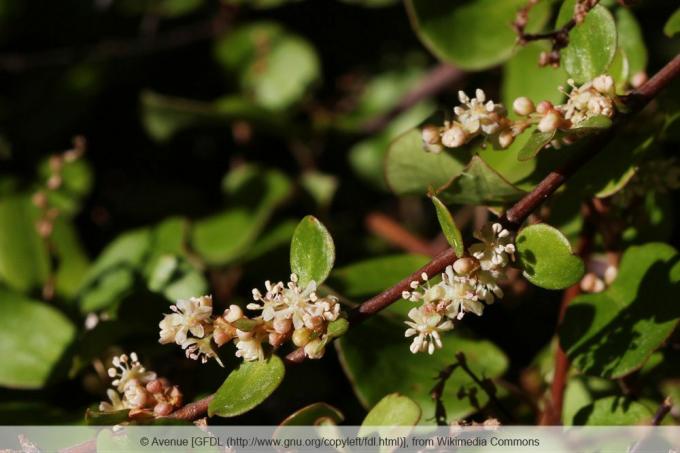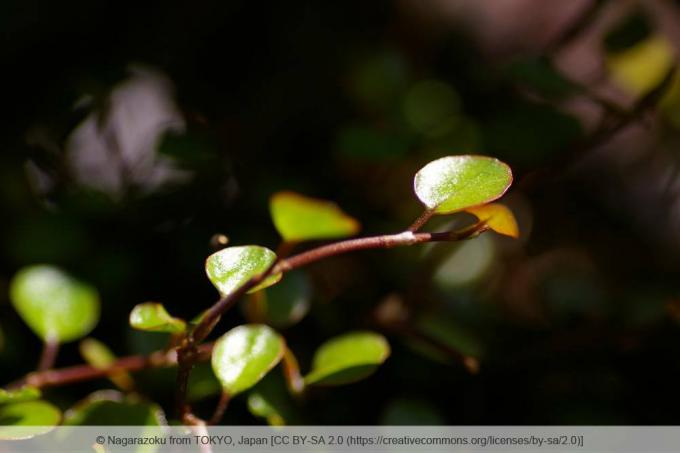
table of contents
- Characteristics
- floor
- Fertilize
- to water
- planting
- Cut
- Location
- Overwinter
- Multiply
Profile and care information open +conclude -
- Flower color
- White
- Location
- Partial shade, sunny
- Heyday
- June July
- Growth habit
- upright, creeping
- Soil type
- sandy, gritty
- Soil moisture
- moderately moist, fresh
- PH value
- neutral, slightly acidic, acidic
- Limescale tolerance
- Calcium intolerant
- humus
- rich in humus
- Plant families
- Knotweed Family, Polygonaceae
- Plant species
- Potted plants, house plants, hedge plants, ground cover, container plants, bedding plants
- Garden style
- Terrace garden, winter garden, rock garden
The so-called wire bush is now one of the most popular ground covers in the garden. The plant is relatively undemanding and requires relatively little maintenance. At the same time, however, it also opens up a multitude of different possibilities for creative garden design. No matter whether as a bed border, as a green accent in a rock garden or in general in combination with other plants - the wire bush is in most cases a really good one and very straightforward Choice.
Characteristics
- Name: Wire Bush
- botanical name: Mühlenbeckia complexa
- Other names: Kiwi-Knöterich, Mühlenbeckie
- Family: Knotweed family (Polygonaceae)
- Origin: New Guinea, Australia, New Zealand, Central and South America
- Flowers: small, whitish, grouped in spikes
- Leaves: green deciduous leaves and smaller stipules
- Growth habit: upright or creeping on the ground
- Height: 5 to 10 centimeters
- Toxic: no
- Winter hardy: conditional, depending on the species
floor

Regardless of whether Mühlenbeckia complexa is to be cultivated as a houseplant or in the garden - it is extremely undemanding in both cases. This also applies to the requirements that they place on the ground or provides the plant substrate. Any kind of soil can be used for this. The only important thing is that it is as loose as possible and permeable to water. The plant does not tolerate waterlogging. If the soil in the garden has a high proportion of clay, it is therefore advisable to install a drainage made of gravel. Mixing sand into the existing soil is also a good idea. And a certain amount of humus is certainly not harmful either.
Fertilize
Even if the care of the wire bush is very easy, regular fertilization is still the order of the day. From April to the end of September, fertilizer should be given about once a month. Ideally, you use liquid fertilizer, which can simply be tipped into the irrigation water. Alternatively, a long-term fertilizer can be used, which is then, for example, in the form of sticks into the soil or the plant substrate is stuck. Then fertilization in April and at the end of June or beginning of July is sufficient. The recommendation of the fertilizer manufacturer must be observed when dosing. Depending on the type and brand, the dosage can vary considerably.
to water

The wire bush needs a lot of water. Therefore, there is no avoiding regular watering. The following applies: The root ball must not dry out under any circumstances. The soil directly around the plant should therefore always be slightly moist. The best thing to do is to check it by hand regularly. As soon as it begins to dry up there, it should definitely be watered. As already mentioned, Mühlenbeckia complexa does not tolerate waterlogging. It would cause the roots to start to rot. In addition, the plant, which is very robust in itself, is more susceptible to diseases. Therefore, watering should always be done carefully and not too much at once.
planting
Planting the wire bush is very easy. You simply dig a small hollow into which the root ball of the plant fits comfortably. Then you fill the free space with earth, press it down and immediately pour it abundantly. If the shrub is to be cultivated as a houseplant, a planter must be used that has a water drain. The introduction of a drainage layer is recommended. This layer can consist of shards or stones. The irrigation water must be able to drain off easily at all times. If several wire bushes are planted outdoors, a planting distance of 20 to 30 centimeters should be maintained.
Cut

A cut is not absolutely necessary for Mühlenbeckia complexa. The plant can, however, be cut to shape it or to stimulate growth. When cultivating in the garden as a ground cover, it is sufficient to simply mow down the shrub completely once in spring. When growing in height and when cultivating in a planter, it is advisable to shorten shoots that are too long or unfavorably growing. This is possible at any time. Especially in the open air, the wire bush often unfolds its splendor when it is simply left to grow wild and untouched.
Location
The shrub likes it very bright. A location that is as sunny to partially shaded as possible is therefore mandatory. This applies both outdoors and when the plant is grown indoors. The blazing midday sun should be avoided as a matter of principle. Although the Mühlenbeckie can cope with it in an emergency, the growth is usually poorer. When cultivating in the apartment, care must also be taken to ensure that there is regular ventilation. Basically, the place can also be a little cooler. Continuous heat or however, high temperatures should be avoided.
Overwinter

When it comes to the question of whether the wire bush is basically hardy or not, opinions differ among gardening enthusiasts. The problem with this: It depends on the respective cultivation or Kind of. There are now around 30 different types available in specialist shops - and not all of them are really hardy. The information about the plant is crucial. In general, however, it can be said that the plant should be overwintered to be on the safe side. This is not a problem when cultivating as a houseplant:
- stop fertilizing between October and March
- Water the plant only moderately
- however, never let them dry out
- ensure a real hibernation at a room temperature of 5 to 10 degrees Celsius
- do not park in the dark
Tip: Even if the wire bush can be overwintered in a warm place, it is still advisable to overwinter in a cool, light-flooded room. This prevents the development of lack of light shoots, which you do not have to cut during the first care in spring.
Wintering outdoors is of course only possible to a limited extent. The plant cannot tolerate permafrost and temperatures below minus 5 degrees Celsius. Most of the time, however, it is possible, depending on the species, to bring them reasonably well protected through the winter. To do this, the entire shrub should be wrapped in a fleece or covered with brushwood. However, no guarantee can be given that the plant will actually survive the winter. It always depends.
Multiply
The Mühlenbeckie can be very easily propagated by dividing the plant and cuttings. The best time for the division is spring. How to proceed:
- Carefully dig out the root ball
- Break the ball of the ball into two equal parts with your hands
- do not use knives or other tools
- Plant the two parts in a suitable location
- Water well immediately after planting
Propagation via cuttings can take place in the apartment all year round. That's how you do it right:
- only cut off shoots with at least three leaves
- put in conventional potting soil
- spend in the brightest possible place
- Ensure a constant temperature of 20 to 25 degrees Celsius
- cover with foil
- Keep the soil moist throughout
- provide regular ventilation
- transplant after roots have formed



